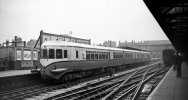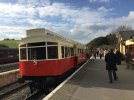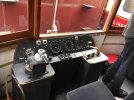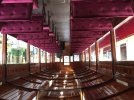The general development of such rail cars followed the road HGV industry developments. The GWR had a particular association with the AEC company, mainstream truck and bus builders, whose factory coincidentally was alongside the GWML at Southall, with private sidings. The 1930s streamlined diesel cars came when road lorries began to change from petrol to diesel, and the gearchange was a new AEC proprietary type called preselector, avoiding a clutch. Bear in mind the railway had large fleets of lorries for freight collection and delivery, with some having significant local bus fleets as well, and would have fitters competent in these mechanical parts all around. The railcars were fully seated, as the engines underfloor were horizontally mounted. This is not as easy as it sounds, with issues like lubrication, but again was an AEC development and used on buses. Vacuum brakes were the same as on buses and lorries of the era.
The LMS developed their cars, strangely, on their Northern Ireland offshoot, the NCC, likewise in conjunction with Leyland Motors, factory on the WCML The engines were vertical, and the gearbox was automatic, out of the 1930s Leyland "gearless" vehicles. The set in the opening picture was a further development, with six engines. It wasn't as reliable as the GWR cars, and spent long periods out of service. When running it was commonly on the Oxford to Cambridge line.
The greatest engineering challenge was the remote operation of further cars when running in multiple. Even with driving controls at both ends of a single car, being able to use one or the other was an issue. Further, both the (pictured) LMS train and the last four GWR cars were formed with a converted hauled coach into two 3-car sets, with the need to control remote engines in the opposite end car for direction and power. This took into the 1950s, and the first BR cars, to achieve. The very first Derby cars, the "Red Triangle" type, had the lightweight bodywork but the mechanical drivetrain of the LMS unit. This was unfortunate as not only were the Leyland parts effectively obsolete, but the pre-war "gearless" transmission was regarded as a failure. Goodness knows what early BR politics led to the choice, but after the 8 pioneer sets were produced the mechanical bits were changed to the AEC type all round, and on they went with thousands of them. Doubtless Swindon smiled - just a bit!
The two old GWR 3-car sets didn't have it all their own way. One of the cars was burnt out in 1947, but a replacement with just one driving cab was later fashioned out of one of the single cars. Then a few years later the other 3-car unit was completely destroyed by fire, end to end, on the outskirts of Bristol. A couple of the single cars went the same way, I've seen a picture of one blazing on what is now the Severn Valley line at Bridgnorth. Meanwhile we, in our early enthusiasm, used to see the remaining "multiple unit", cars 33 and 38, arrive at Bristol Temple Meads on Saturday afternoons in 1961-62, from Bath and I think down the Weymouth line. It was still in red and cream livery.









